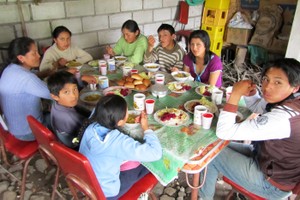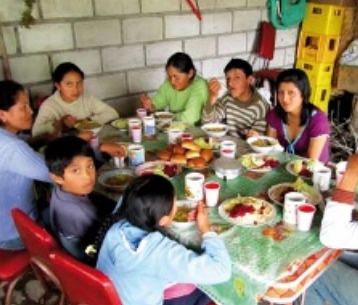One of the greatest challenges facing the world is to ensure that everybody has access to adequate food that is healthy, safe and of high nutritional quality – and to do so in a manner that is environmentally sustainable. At present the current global food system is dramatically failing to deliver on this goal. It is estimated that a billion people go hungry or suffer from lack of vital micronutrients, while, at the other extreme, an even greater number of people are suffering from the effects of overweight and obesity as a consequence of eating unhealthy foods. The costs of treating the impacts of this double burden run into billions of dollars. Clearly, there is an urgent need for fundamental change.

One of the greatest challenges facing the world is to ensure that everybody has access to adequate food that is healthy, safe and of high nutritional quality – and to do so in a manner that is environmentally sustainable.
At present the current global food system is dramatically failing to deliver on this goal. It is estimated that a billion people go hungry or suffer from lack of vital micronutrients, while, at the other extreme, an even greater number of people are suffering from the effects of overweight and obesity as a consequence of eating unhealthy foods.
The costs of treating the impacts of this double burden run into billions of dollars. Clearly, there is an urgent need for fundamental change.
Barriers to change
There are many obstacles hindering a shift towards better or more efficient food systems. All too often countries have inappropriate agricultural and food security policies and strategies in place, disregarding nutritious species such as millets, indigenous fruits, vegetables, roots and tubers. This may be further compounded by trade policies which undermine the promotion and consumption of such foods by allowing the importation of cheap foodstuffs.
Tariff and non-tariff barriers place a considerable burden of proof on the commercialisation and consumption, at all levels, of biodiverse foods. The European Union’s Novel Foods Regulation is one of the many examples of ways in which international trade is limited. Similar difficulties exist within regions, as shown by Fonseca and Burke, or even within countries.
At the same time, the world has seen major shifts in diets. Globalisation, industrial development, population increase and urbanisation have changed patterns of food production and consumption in ways that profoundly affect ecosystems and human health. Highinput industrial agriculture and long-distance transport increase the availability and affordability of refined carbohydrates and fats, leading to less nutritious diets and to a greater reliance on a limited number of energy-rich foods. This has resulted in a considerable disconnection between diets and local food sources, a situation that threatens the continued existence of much of the world’s biodiversity and the ecological knowledge associated with it. Fewer and fewer children know about where or how their food is produced or the types and varieties of species that their parents and grandparents would have known.
Well-tried solutions
Clearly there is no silver bullet solution to such a complex problem. The challenge of reversing a dysfunctional global food system will require a sustained, co-ordinated and multidisciplinary approach – we need more than just “connecting” farmers and their products to the global markets. It will require the integration and application of the social and natural sciences, considering both public health and agricultural issues; looking at how food is marketed and the policies and regulations which inhibit or promote different patterns of production and consumption.
It is possible to simultaneously give producers and consumers a better deal. The articles in this issue, just a few of many examples from around the world, show the potential of regional food systems in achieving this. The benefits are many, and are not limited to lower transportation costs, less risky transactions, or producers receiving a higher price for their products. More diverse production (with benefits to farms, soil and biodiversity) leads to more diverse, and therefore healthier, diets. And, as shown by Partridge, more personal forms of exchange help farmers and consumers exert a greater degree of control over what is produced and consumed.
Challenges
Developing local markets involves challenges, including overcoming the obstacles referred to above. Farmers’ access to markets remains poorly organised, while efforts to increase the commercialisation of their products demand that these products are uniform, that large quantities are supplied on a regular and reliable basis, and that attention is paid to issues of food safety. In most places there is still a lack of market information, of transport and processing facilities, inadequate marketing infrastructure and a genuine lack of co-ordination along the supply chain. Overcoming these factors increases transaction costs, at least initially. Yet these problems can be tackled, as several experiences with strengthening local and regional chains show.
Working with the Uchumi Supermarkets and with other local partners in Kenya, Bioversity International has helped farmers and communities to get their leafy vegetables to urban consumers. The results have been quite astonishing, with a growth in sales of more than 1100% in just two years and with networks of over 300 growers now linked to urban markets. Similar examples can be found elsewhere, involving large and small businesses, farmers’ organisations, enthusiastic advocates and consumers. The Incredible Edible Todmorden movement described by Paull, or the Formby Edible Gardens Project, the Transition Towns movement, and other community-supported agriculture projects, show that the development of more equitable and efficient food systems requires information, advocacy and motivated campaigners.
Most important, perhaps, is the political will to achieve better results. The PAA policy framework developed in Brazil shows that political support can create an “enabling environment” and systems that support producers while increasing food security and food sovereignty. These are the examples that should illuminate the discussions in future events like Rio+20.
Text: Danny Hunter, Jessica Fanzo and Edith van Walsum
Danny Hunter and Jessica Fanzo work as Senior Scientists with Bioversity International. Edith van Walsum is ILEIA’s Director.

